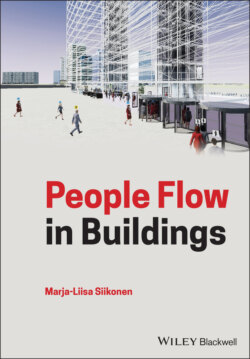Читать книгу People Flow in Buildings - Marja-Liisa Siikonen - Страница 26
2.4 Use of Optical Vision
ОглавлениеIn‐house people‐counting with cameras and video techniques has become popular since the sizes of cameras have rapidly decreased, and accuracy has improved during the last years. Also, the revolutionary development of storing data to DVDs, flash memories and cloud services has accelerated the development and use of optical vision. In Figure 2.2a camera is set above a doorway. Such passenger counters can be positioned also at the entrance doors (Footfallcam 2019 ).
Figure 2.2 Camera installed above the doorway for people‐flow counting (a) and optical vision with two stereoscopic cameras
(Source: Pinna et al. (2010 ). © U.S. Department of Transportation [US DOT]) (b).
Optical vision can be placed in the lobby entrances and on the roof inside an elevator. On elevator roofs, cameras have earlier been installed for safety purposes to detect unfamiliar objects inside a car, or to recognize the free space in the elevator. Optical vision solutions are able to detect even the shapes of the passengers and identify either the entry or the exit movements. Two stereoscopic cameras can be mounted perpendicular, normally 2–5 m, above the area to be detected, as in Figure 2.2b (Pinna et al. 2010 ). The measured data can be saved to a main computer, or streamed to a server or to cloud. Along with the video image, the date and time are recorded which allow later statistical analysis. Video analytics employs, e.g. a multilayer technique to distinguish only the moving objects on the video where the background is subtracted from the foreground image (Yao and Odobez 2017 ). There are multiple suppliers for the camera‐based technique. With 3D‐cameras, the data is more stable compared to the normal 2D‐cameras. These types of sensors are capable of finding, for instance, the visitor counts in a football stadium, or the duration of customer visits in shopping malls.
